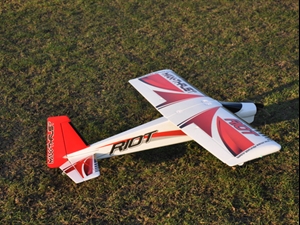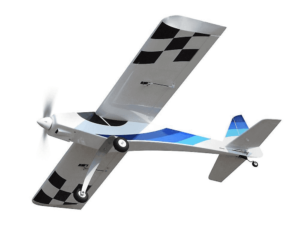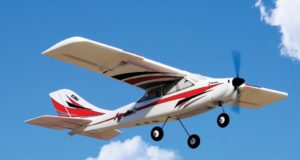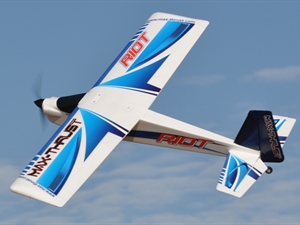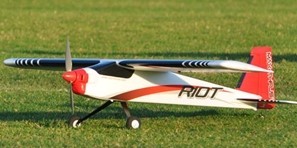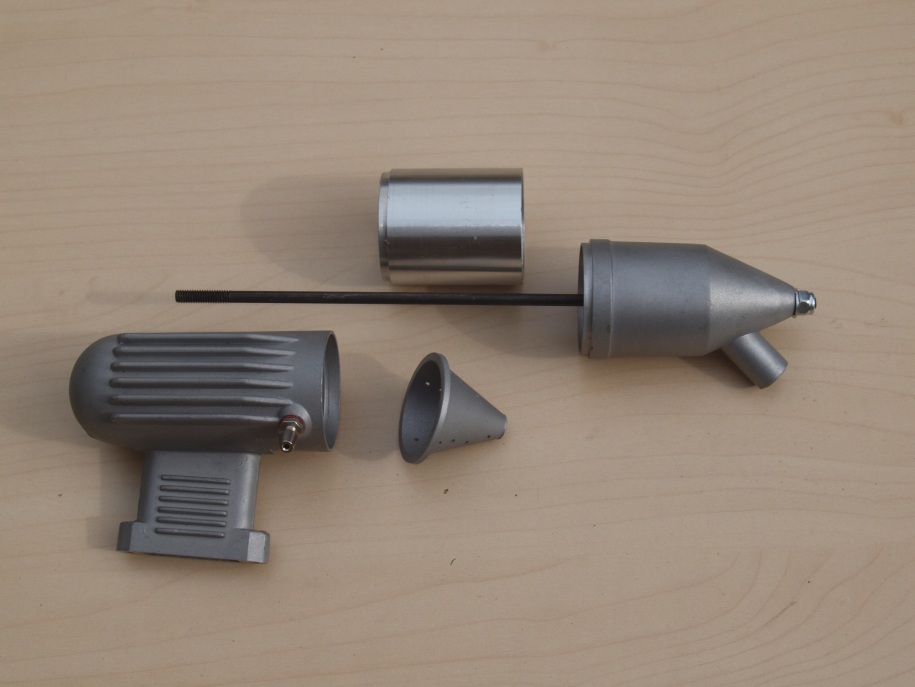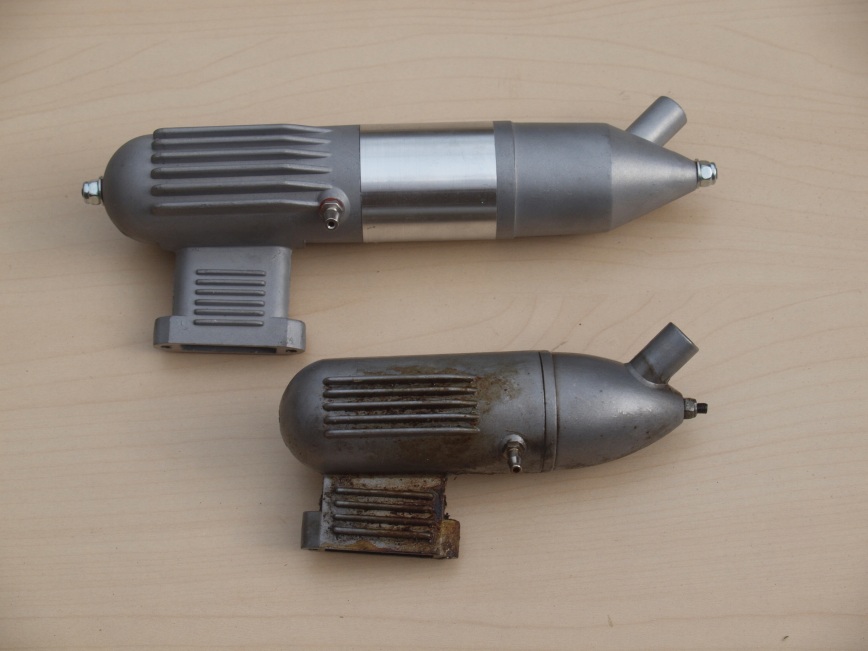Features:
- Which trainer?
- Max Thrust Riot
- Just Engines ‘Super Quiet’silencer
- 3. Ripmax ‘Wot 4’
Scroll down the page!
Which trainer?
The person with the greatest experience of current trainer aircraft in our club is Paul Appleyard, as he does the majority of instructing, so below are his brief comments on the most popular electric powered offerings.
In general though bigger is better, especially for mature eyes: if you can’t see it you can’t fly it! And what about ‘traditional’ glow-powered trainers? In general these tend to be bigger, heavier and fly better than their electric counterparts (and with longer flight times).
Unfortunately, in today’s market place it is getting very difficult to buy a new i.c. engine of around 0.40-0.50cu.in. displacement although readily available second hand. This in turn means that fewer and fewer Almost Ready To Fly trainer models are in production although there are plenty of plans available for those who want to build their own models.
And while 2-stroke and 4-stroke i.c. engines are great fun to operate, they do require investment in ancillary equipment such as starter motors, glow plug igniters, glow fuel and other minor items.
Max Thrust Riot V2: a conventional-style trainer
Looking for a ‘first’ R/C model? Then the Riot is certainly worth closer examination as proven by a couple of examples seen at our flying field.
Moulded from a relatively tough foam it is of very conventional layout, spanning 1400mm (55.1in) and weighing in at 1350g (47.6oz) ready to fly: big enough to have reasonable presence in the air and quite capable of handling wind speeds of up to 12mph which is around the most that beginners will wish to fly in.
It is available in three different formats:
- ‘Ready to Fly’ complete with transmitter, receiver servos, flight battery and charger at around £240
Would suggest that you ignore this version as the transmitter is not compatible with the Club’s buddy box system.
- ‘Plug and Play’ which means that all the servos, the speed controller and motor are all pre-installed costing about £160
This is the one to go for, just leaving you to buy your own R/C system, flight batteries and charger.
- Airframe only at £99.95
Worth considering if you have a severe crash as cheaper than buying a full set of individual spare parts.
There’s a full review from RCM&E here (why do they never give Learner models to Learners?) and of course Mr Google will find you lots of comments, some rather less sensible than others (!) but this is what a couple of our trainee members thought:
Graham Walker bought this as his very first model and reports that from his point of view and limited experience, he is very happy with the Riot. He found it well packaged, easy to put together (no glue required) and the instructions easy to follow. All he had to do was to centre one servo and slightly line up the control surfaces. All the clevises have pieces of tube to secure them already fitted and you get four spare clevises in the box.
It flew well on its first flight (Graham is to be commended for arriving at the field with his model fully ready to fly, with the CG checked and everything working correctly) and it only needed about six clicks of up elevator trim. He found it easy to see in the air and very docile though it happily loops and rolls – which he performed on that initial flight. Stick time on a flight simulator certainly paid off for him!
His flies for ten minutes on a 3S 2200mAh battery, but obviously he is not pushing the flight envelope too much just yet. The wheels are a decent size and it handled the longer grass ok. Graham has already been performing his own take-offs, which were achieved without drama as the model tracked in a straight line with little rudder needed.
As he hasn’t yet crashed, he doesn’t know about repair-ability…but he has had an occasional ‘incident’ – see below.
Graham added: “My very first flight was with Roger’s Wot 4 Foam E. Shortly after I flew a Bixler. This put me off the Bixler, so it was a going to be a toss-up between the Wot 4 or the Riot. I got the Riot because it is a bit bigger and heavier – and don’t regret it. It’s certainly more responsive than a Bixler”.
A further update from Graham after several more months of ownership :”I got my Riot from Nexus in Northampton for just under £150 with free delivery.I haven’t noticed the prop adaptor problem (Tony King suffered from an out-of-true prop), no vibration on mine.I use Overlander batteries which are £17 each, no issues so far. Hobby King had no suitable batteries in stock at the time: 4 Max batteries are about £6 more expensive – even more so with a £9.49 delivery charge and don’t have a plug, on so you have to solder your own.
Riots come with a Deans connector on the ESC so you will need to change this or get an adapter to use batteries with an XT-60 connector.
As for a battery charger, again nothing in stock at Hobby King so I got a SKYRC T200 from Al’s for £78. This charges two batteries a time at up 100W each. I have had no problems so far. I use a Spektrum AR620 antenna-less receiver which is very small and easy to mount in the fuselage under the wings.
So far so good with my Riot, I’ve had to straighten the undecrarriage a few times and bent a wheel axle.I also bent the wing joiner bar after a bad landing and cartwheel, leading to drooping wings, anhedral? A new wing joiner is £5 from Century, but I managed to straighten mine.
Last time out I broke the prop on landing so fitted an APC Thin Electric 11×5.5, this needed to be cleaned out slightly with a 6mm drill to fit the prop adapter but is much better quality than the original. I don’t know how it performs as I haven’t flown it yet.
The Riot was originally supplied with a 12 x 6 prop but later ones have an 11 x 5.5, I understand this was to reduce load on the ESC so I will stick with this for the time being.
Another fan of the Riot is Roger Salter who has had rather more airtime with the model than Graham. He liked the fact that it took just 30 minutes to assemble but found the battery box a little flimsy and it only takes a 2200 3S pack, but it does the job. He reports that spare parts are readily available (not always the case) – and the distributors Century UK have an excellent reputation for aftersales service.
He continues: “The undercarriage is not fond of heavy landing and will rip off – a problem with all foamies – and the engine cowl fixing is a little weak.
“I smashed mine several times but a bit of glue and it was flying again… until a full-throttle nose dive spread the fuselage and wings across a wide area. Set the rates low and it is very gentle: higher rates and it can be a bit mad doing all the tricks (flown by Paul).
Roger found that it does tend to land a little fast, but that may be his landing technique – his instructors found it floated in fine.
Overall he rated it a good plane once set up and would have replaced his original with another, but it was not available at the time so he bought a Wot 4 foamie instead – which he finds very similar indeed.
Just Engines ‘Super Quiet’ silencer
by Peter Richardson
When the Thunder Tiger 36 in my ‘X-S’ fun-fly failed the noise test, I was not surprised: these lightweight models need a fine-pitch prop and lots of revs to get their fast climb rate. More surprising was that it only failed in one direction, and then by just 1.5dBA.
A phone call to Just Engines brought me their Super Quiet muffler, described on their website as being a three-part unit (front, middle and rear sections), having a thin baffle with punched holes that could be placed either in front of or behind the middle section. This gave the option of variable noise/power restriction – with further ‘adjustment’ being possible by either hammering the punched holes closed to reduce their diameter, or opening them up long-nose pliers.
A little crude, perhaps, but at least it allows some tuning. They also suggested that passing a bolt through the outlet pipe would further reduce noise simply by adding an extra restriction – though cautioning against increased back-pressure/overheating.
They offer three different sizes (depending on distance between muffler mounting holes): the advantage of the Chinese manufacturers all copying OS engines is that items like this become virtually universal: the TT36 required their smallest unit (35mm bolt spacing) and cost just £16.50 plus postage. Other sizes available are 37mm and 42mm.
On arrival, I pulled it apart and found that the design has clearly moved on since the web site was written (at least in respect of this smallest unit): in place of the crude-sounding baffle plate was a cast cone, complete with some 24 drilled holes each of a mere 1.17mm diameter. That means a total of 25.8mm2 for the gases to pass through. Not a lot. Once past that, they can exit via the outlet pipe – much bigger at 27.3 mm2!
Compared to the stock silencer, this new unit was at least twice the volume, weighed 144 grammes instead of 66 grammes, and had an outlet pipe diameter of just 5.9mm compared to the original’s 8.2mm.
Frankly, looking at the size of the holes in the cone, it seemed that this was going to be VERY restrictive: I had to blow through the unit to convince myself that any exhaust gases could actually pass through…
There were no ‘instructions’ with the unit, though it appeared well made and came nicely packaged with three Allen keys (two of which were of no use as they were of a different size to the cap-headed screws provided (!), and a gasket.
Expecting the unit to be over-restrictive in terms of power output, I went to the flying field armed with a drill and numerous bits so that I could enlarge the holes in the cone.
First though I left the old silencer on and ran the engine on its usual 11×4 APC prop, recording 12,200-400rpm – just what it usually delivers. The worst noise level recorded was 83.5dBA (tail). With the new silencer in place, and with the cone mounted in front of the centre section to give the smallest initial chamber, the needle was screwed in until it peaked at 11,600rpm – but now it tested with a worst noise level of a mere 75dBA!
Richening the needle one click, a test flight showed that the initial acceleration from take-off was a little down, but nothing to worry about. And despite my worst fears it ran fine – starting easily by hand, throttling being unaffected.
Before the next flight I moved the cone back behind the turned section to give a larger initial chamber, then re-tested without touching the needle. Now the rpm was up to 12,000-12,200, and the noise meter peaked at 78.2dBA. In flight, the performance was no different from the original: it climbed vertically from take-off – what more can you ask? The model did require an extra 28g of lead on the tail to counteract the extra noseweight, but that made no discernable difference.
I suspect that I could improve performance over the original silencer (there are lots of possibilities, ranging from removing the cone and/or centre section to enlarging the holes in the cone and/or tailpipe) and still be under the noise limit – but see little point. It goes as well as ever, has no noticeable adverse-effects such as increased back pressure or overheating. And morally, shouldn’t we make our models as quiet as we can?
Noise levels:
Standard Super Quiet Super Quiet
12,200-12,400rpm Cone in front Cone behind
A (nose) 81dBA 74dBA* 77dBA
B (RH) 75dBA 75dBA 78.2dBA
C (LH) 80dBA 71dBA 73.5dBA
D (tail) 83.5dBA 74dBA 74.7dBA
* Engine bit cold and not on full song
Incidentally, Just Engines also sell a range of ‘Quiet’ silencers which are effectively the same as the ‘Super Quiet’ but without the centre section.
Ripmax ‘Wot 4’
By Peter Richardson
I’ve never really understood the ‘cult’ of the Chris Foss Wot 4, but when I needed a quick-build winter hack, the ARTF Ripmax version looked like it would fit the bill, especially with a price tag of just under £90.
Certainly, there’s little to complain about. Build quality proved fine, instructions detailed and accessory pack adequate – though I chose not to use much from its contents. My first thought was to fit an ASP52 four-stroke, but the engine mount supplied was too wide for its crankcase, and being in bit of a rush, I couldn’t be bothered to fit an alternative. Instead, an Irvine 53 fitted just fine, though at the top-end of the recommended range.
A simple glass fibre cowl is provided that fits-where-it-touches and does the job, leaving much of the engine/carb exposed for easy access. Nothing wrong with that, and contributing to the rapid assembly: a week of (short) evenings saw it ready to fly.
The dural undercarriage offers very little ‘spring’, and is mounted at an angle on the bottom of the fuselage so that the shock of landing is transmitted straight to the plywood mount. It looked a bit vulnerable, so I used plastic bolts to hold it in place. Unfortunately, these have a thread that is close to that of the supplied T-nuts – but not the same. Consequently they tended to strip if over tightened.
In practice, if ‘arriving’ off the landing area (!) they snapped – but at least the fuselage did not get damaged. Finally, I gave up replacing the bolts and instead installed a piano wire torsion-bar style undercarriage which was very successful in withstanding even hard landings without any damage. Other users in the Club have reinforced the area with glass fibre: clearly the undercarriage is a weak point – as with most ARTF kits.
And the flight performance? Fine – but in my opinion it failed to live up to the hype. Nothing wrong mind you, and it would fly impressively slowly without stalling. But the old-fashioned and rather narrow strip ailerons deliver a relatively mild roll rate, and the rudder and elevator are under-sized compared to modern counterparts. This is no 3D machine, though it was used by the pioneers of prop-hanging to achieve this ‘abnormal’ flight practice. They will tell you that it was good training for this – but more modern models will achieve prop hanging far more easily. Not that i can pass an opinion on this…
Incidentally, the ARTF model is the Mk2 Wot 4 with a parallel chord wing, while the build-it-yourself version (ironically considerably more expensive than the ARTF!) is a Mk3 with a tapered wing.
On my version, I need a significant amount of up elevator trim (3mm) to maintain level flight on mid throttle, suggesting an error in the wing or tailplane incidence, and I also needed to move the CG back at least 15mm than suggested. This was achieved by fitting the five cell battery pack below the servos (tight squeeze!) at the rear of the radio bay.
With a 12×6 prop fitted, the Irvine 53 gave sufficient performance with low noise output – but certainly not in ‘hooligan’ mode.
Would I recommend it? Yes, no question – it would be a fine second model after a trainer, and certainly met my need. But do look at improving the undercarriage. Or learn to perfect your landings.
And if you are wondering why there are no pictures and I am no longer to be seen flying it, then that’s because I had a fly-away with it. No problem with the radio: I simply looked away too long when moving from the take-off strip to the pilot’s box, and by the time I ‘found’ it again, it was too late…

